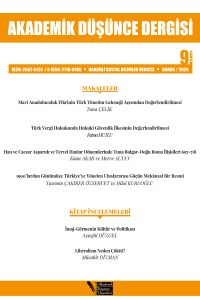Öz
In this study, it is aimed to read the spatial traces of international migration to Turkey in the last 30 years through existing migration data and to develop policy recommendations from these data. In the study, the last 30 years are analysed in three separate periods of ten years. The first period is the period between 1990-2000 and points to the process of transformation of the country from a country of emigration to a country of transit migration. The period between 2000-2011 represents the process of transformation from a transit migration country to a country of extended stays and a receiving country and this transition. The period after 2011 describes the process of transformation into a receiving country, especially a country of asylum. These three processes are analysed in a way to include readings of spatial traces in terms of cities and settlements across the country. For this purpose, the spatial distribution of migrants has been determined by using literature review and content analysis methods. In this context, it has been determined that more focus should be given to the border regions where migrants enter the country and where they are concentrated to cross to other countries. It is essential that the studies to be conducted should be multi-actor and multi-dimensional. In particular, local actors should be brought to the forefront; in addition to legal and institutional activities, economic, psychological and sociological activities and an inclusive urban design approach should be included.
Anahtar Kelimeler
International migration migration and space settlement policy migration policy.
Kaynakça
- AFAD. (2013). Türkiye’deki Suriyeli Sığınmacılar, 2013 Saha Araştırması Sonuçları. AFAD.
- AFAD. (2014). Syrian Guests in Turkey. AFAD.
- AFAD. (2017). Türkiye'deki Suriyelilerin Demografik Görünümü, Yaşam Koşulları ve Gelecek Beklentilerine Yönelik Saha Araştırması. AFAD.
- Akçadağ, E. (2012). Yasa Dışı Göç ve Türkiye, Bilge Adamlar Kurulu Raporu, Rapor No: 42. İstanbul:Bilgesam.
- Aktepe, E., Tekdere, M. ve Gürbüz, A. Ş. (2017). Toplumsal Uyum ve Bütünleşme Bağlamında Erzincan’a Yerleştirilen Ahıska Türkleri Üzerine Bir Değerlendirme. Göç Araştırmaları Dergisi, 3(2), 138-169.
- Aydın, T. (2009). Türk İdare Sisteminde Yerleşik Yabancılara Yönelik Bir İdari Örgütlenme Modeli: Göçmen Ofisleri. (yayımlanmamış yüksek lisans tezi), Akdeniz Üniversitesi, Sosyal Bilimler Enstitüsü, Antalya.
- Aydıngün, A. (2021). Ahıska Sürgünü, https://www.ytb.gov.tr/dosyalar/ahiska-surgunu, Erişim Tarihi: 19.11.2022.
Öz
Bu çalışmada, son 30 yılda Türkiye’ye yönelen uluslararası göçün mekânsal izlerini; mevcut göç verileri üzerinden okumak ve bu verilerden politika önerileri geliştirmek amaçlanmıştır. Çalışmada, son 30 yıl onarlı yıllardan oluşan üç ayrı dönemde ele alınmaktadır. İlk dönemi, 1990-2000 yılları arası oluşturmaktadır ve ülkenin göç veren ülkeden, transit göç ülkesine dönüşme sürecine işaret etmektedir. 2000-2011 yılları arası dönem ise, transit göç sürecinden uzayan kalışlar sürecine ve göç alan ülkeye doğru dönüşme süreci ve bu geçişi temsil etmektedir. 2011 sonrası dönem ise, göç alan, özellikle de sığınılan ülkeye dönüşme sürecini tariflemektedir. Bu üç süreç, ülke çapında, şehirler ve yerleşmeler anlamında mekânsal izlerin okumalarını içerecek şekilde ele alınmıştır. Bunun için literatür taraması ve içerik analizi yöntemleri kullanılarak göçmenlerin dönemsel olarak mekânsal dağılımları tespit edilmiştir. Bu bağlamda, göçmenlerin ülkeye giriş yaptıkları ve diğer ülkelere geçmek üzere yoğunlaştıkları sınır bölgelerine daha fazla odaklanılması gerektiği tespit edilmiştir. Yapılacak çalışmaların çok aktörlü ve çok boyutlu olması esastır. Bilhassa yerel aktörler ön plana çıkarılması; yasal ve kurumsal faaliyetlerin yanında ekonomik, psikolojik ve sosyolojik faaliyetlere ve kapsayıcı kentsel tasarım anlayışına yer verilmesi gereği kendini göstermiştir.
Anahtar Kelimeler
Uluslararası göç göç ve mekan yerleşim politikası göç politikası.
Kaynakça
- AFAD. (2013). Türkiye’deki Suriyeli Sığınmacılar, 2013 Saha Araştırması Sonuçları. AFAD.
- AFAD. (2014). Syrian Guests in Turkey. AFAD.
- AFAD. (2017). Türkiye'deki Suriyelilerin Demografik Görünümü, Yaşam Koşulları ve Gelecek Beklentilerine Yönelik Saha Araştırması. AFAD.
- Akçadağ, E. (2012). Yasa Dışı Göç ve Türkiye, Bilge Adamlar Kurulu Raporu, Rapor No: 42. İstanbul:Bilgesam.
- Aktepe, E., Tekdere, M. ve Gürbüz, A. Ş. (2017). Toplumsal Uyum ve Bütünleşme Bağlamında Erzincan’a Yerleştirilen Ahıska Türkleri Üzerine Bir Değerlendirme. Göç Araştırmaları Dergisi, 3(2), 138-169.
- Aydın, T. (2009). Türk İdare Sisteminde Yerleşik Yabancılara Yönelik Bir İdari Örgütlenme Modeli: Göçmen Ofisleri. (yayımlanmamış yüksek lisans tezi), Akdeniz Üniversitesi, Sosyal Bilimler Enstitüsü, Antalya.
- Aydıngün, A. (2021). Ahıska Sürgünü, https://www.ytb.gov.tr/dosyalar/ahiska-surgunu, Erişim Tarihi: 19.11.2022.
Ayrıntılar
| Birincil Dil | Türkçe |
|---|---|
| Konular | Kamu Yönetimi |
| Bölüm | Araştırma Makalesi |
| Yazarlar | |
| Erken Görünüm Tarihi | 30 Haziran 2024 |
| Yayımlanma Tarihi | 30 Haziran 2024 |
| Gönderilme Tarihi | 15 Mayıs 2024 |
| Kabul Tarihi | 28 Haziran 2024 |
| Yayımlandığı Sayı | Yıl 2024 Sayı: 9 |

